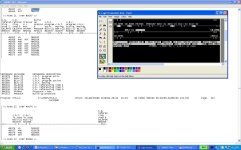Steve Bailey
Lifetime Supporting Member + Moderator
Those are names the program's author assigned to the discrete points. In a current software package they would be called tagnames or variable names. In Logicmaster they were limited to seven characters. I'm equally clueless by what the author had in mind.bits like B03<-21 I am clueless about
To see more of your documentation on screen, hit <ALT> + N repeatedly. That will cycle through the various display options. You can look at just the nickname (which is what's displayed in your screen shot), the address, the nickname plus the three-line reference description, or the address plus reference description. The one thing you can't get on the screen at the same time is the nickname plus the address.
The IC693APU302 motion controller modules use a mixture of discrete input (%I), discrete output (%Q), analog input (%AI), and analog output (%AQ) addresses. The manual for the module is GFK-0840*, where * is the revision letter. I believe the last revision was GFK-0840D.
There are 32 %I inputs assigned to each DSM302 module which give you information about the module and each axis. There are 32 %Q outputs per module. They allow you to command each axis from ladder logic. There are 27 %AI analog inputs per module. That's where you'll find your feedback information. Some of the returned data (like axis positin and velocity) will be in 32-bit integer format which means the data takes up two consecutive %AI addresses. Finally, the module uses six %AQ analog output words, three words for each axis. You can use those to command specific motion like moving to an absolute position. The meaning of each of the addresses is covered in chapter 4 of the manual.
As to your referencing issue, I've seen cases like yours where the axis stalls trying to find home. The position error is small and the servo drive can't generate enough torque to overcome the frictional drag. You may need to increase the position loop gain or the homing speed. You'll find those parameter settings in the hardware configuration. Module configuration is covered in chapter 3 of the manual.



